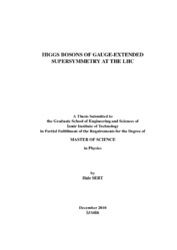Please use this identifier to cite or link to this item:
https://hdl.handle.net/11147/3058Full metadata record
| DC Field | Value | Language |
|---|---|---|
| dc.contributor.advisor | Demir, Durmuş Ali | en |
| dc.contributor.author | Sert, Hale | - |
| dc.date.accessioned | 2014-07-22T13:50:48Z | - |
| dc.date.available | 2014-07-22T13:50:48Z | - |
| dc.date.issued | 2010 | en |
| dc.identifier.uri | http://hdl.handle.net/11147/3058 | - |
| dc.description | Thesis (Master)--Izmir Institute of Technology, Physics, Izmir, 2010 | en |
| dc.description | Includes bibliographical references (leaves: 72-75) | en |
| dc.description | Text in English; Abstract: Turkish and English | en |
| dc.description | ix, 79 leaves | en |
| dc.description.abstract | This thesis work is devoted to a detailed phenomenological analysis of the Higgs sector of gauge-extended supersymmetry in light of the most recent experimental bounds. Such extra gauge symmetries, obtained by adding an extra Abelian symmetry U(1). to the gauge structure of the Standard Model (SM) and Minimal Supersymmetric Standard Model (MSSM) which have the same gauge structure, are urged by the . problem of the MSSM, and they also arise frequently in low-energy supersymmetric models stemming from GUTs and strings. We analyze the Higgs boson masses and their dependencies on various model parameters. In particular, we compute masses of all the Higgs bosons, and confront the mass of the lightest one with the LEP and Tevatron experiments. Then we indicate the restrictions from LEP and Tevatron bounds on the masses and remaining model parameters. We analyze correlations among various model parameters, and determine excluded regions by both scanning the parameter space and examining certain likely parameter values. Furthermore, we make educated projections for LHC measurements in light of the LEP and Tevatron restrictions on the parameter space. As a result of this thesis work we find that .-problem motivated generic lowenergy U(1). model yields lightest Higgs masses as large as . 200 GeV, and violates the Tevatron bounds for certain ranges of parameters. However, we find that U(1). model stemming from E(6) breaking elevate Higgs boson mass into Tevatron.s forbidden band when U(1). gauge coupling takes larger values than the one corresponding to one-step GUT breaking. We also obtain that the Tevatron bounds put strong restrictions on certain parameters of the U(1). model and they lead to determinations of certain parameter ranges before the LHC measurements. | en |
| dc.language.iso | en | en_US |
| dc.publisher | Izmir Institute of Technology | en |
| dc.rights | info:eu-repo/semantics/openAccess | en_US |
| dc.subject.lcsh | Supersymmetry | en |
| dc.subject.lcsh | Higss bosons | en |
| dc.title | Higgs bosons of gauge-extended supersymmetry at the LHC | en_US |
| dc.type | Master Thesis | en_US |
| dc.institutionauthor | Sert, Hale | - |
| dc.department | Thesis (Master)--İzmir Institute of Technology, Physics | en_US |
| dc.relation.publicationcategory | Tez | en_US |
| item.languageiso639-1 | en | - |
| item.fulltext | With Fulltext | - |
| item.openairecristype | http://purl.org/coar/resource_type/c_18cf | - |
| item.openairetype | Master Thesis | - |
| item.grantfulltext | open | - |
| item.cerifentitytype | Publications | - |
| Appears in Collections: | Master Degree / Yüksek Lisans Tezleri | |
Files in This Item:
| File | Description | Size | Format | |
|---|---|---|---|---|
| T000877.pdf | MasterThesis | 871.73 kB | Adobe PDF |  View/Open |
CORE Recommender
Page view(s)
128
checked on Jul 22, 2024
Download(s)
74
checked on Jul 22, 2024
Google ScholarTM
Check
Items in GCRIS Repository are protected by copyright, with all rights reserved, unless otherwise indicated.